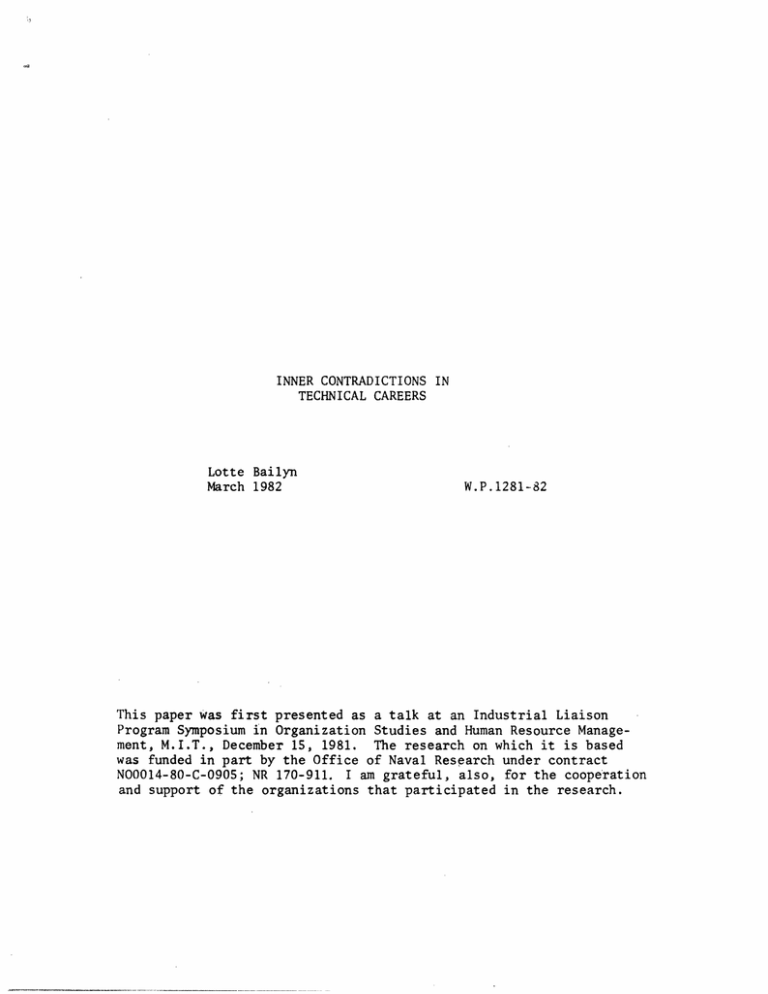This paper was first presented as ... Program Symposium in Organization Studies and ...
advertisement

INNER CONTRADICTIONS IN TECHNICAL CAREERS Lotte Bailyn March 1982 W.P.1281-82 This paper was first presented as a talk at an Industrial Liaison Program Symposium in Organization Studies and Human Resource Management, M.I.T., December 15, 1981. The research on which it is based was funded in part by the Office of Naval Research under contract N00014-80-C-0905; NR 170-911. I am grateful, also, for the cooperation and support of the organizations that participated in the research. This paper deals with some thoughts on technical careers that have emerged from a long-range research program, a program that is beginning to suggest certain interesting conclusions relevant to the management of technical professionals. It is not yet a finished story, but we know--at least in outline form--the beginning, the plot structure, and some parts at least of the conclusions. It began with a study of MIT alumni some 15 or so years into their careers, a group of highly trained scientists and engineers working in a variety of positions in private industry, non-profit labs, or universities. One finding from this study was particularly striking, and sparked off the subsequent line of inquiry. The data showed that one group among the MIT alumni seemed to be in some trouble at this mid-point in their careers. This troubled group consisted primarily of engineers who were still working as engineers--who had remained faithful to their original interests and training. It turned out that this group of committed engineers had more negative reactions to their work than any other: they were less satisfied with their jobs, less involved with their work, and perceived themselves as less successful. What was particularly disturbing was the fact that it was the technically most competent among them (those most interested in technical work and most highly rewarded by their organizations) who were the most negative of all (Bailyn, 1980). Clearly there was something wrong here, though from these original data one could only make conjectures. from the "ills" of middle age: Perhaps these people were simply suffering perhaps they were having a "mid-life crisis" or were suffering from "burnout." But these notions did not explain why it ·was that just those in engineering staff positions, and particularly those who were most technically competent, were the ones who showed the most negative reactions to their work. - 2 - The first thing we did to try to understand this finding was to go back to some of them (now 8 years after the original study) and talk to them in greater detail about their work and their reactions to it. From these second level data we isolated a group of engineers who were most committed to their technical work and for whom these problems were particularly acute. What was important to this small group of highly committed but especially troubled engineers was to be involved in the solution of technical puzzles. I call them puzzles because, like jigsaw puzzles or crossword puzzles, they have certain attributes in common of which three seem to be critical: 1) a puzzle is a problem for which a solution exists--true for jigsaw puzzles and crossword puzzles, not necessarily true for all scientific problems; 2) the procedures to reach a solution are known, and known to the person working on the puzzle--unlike an American trying to solve a British crossword puzzle; and 3) there is fairly immediate feedback from the work itself on whether or not one is on the right tack. It is these attributes that were of critical importance to this particular group of troubled engineers. For them, doing work that meets these criteria is important because it is tied to their feelings of competence, to their sense of self-worth. Here is a quote from one of these people which makes this point: In engineering you are quickly calibrated or evaluated. You can measure the efficiency of a product and this gives you an evaluation of your own success or failure... In some professions you never know whether you succeed or fail. You can convince yourself, but you never have solid proof whether you have done well. That's the advantage of hard core engineering. And yet, this same person not only feels he has not had an entirely satisfactory career, he feels in fact that he should have gone into a different field altogether. What happened, it seems, was that he could not find an organizational position in which he could grow and gain recognition - 3 and still retain the involvement with technical puzzles that meant so much to him. His solution was a compromise, and a risky one. He opted for the role of "internal consultant"--the sole authority in his company of a very specialized area. It met his need to solve technical problems, but it left him isolated in his organization and highly vulnerable to changes in technology. Others in the same situation, we found, made the exactly opposite choice. They worked into management and gave up the satisfaction derived from technical work in exchange for the status, recognition, and pay that they felt they could not get by adhering to their original goals (Lynch and Bailyn, 1980). It is the presence of this dilemma for the technically oriented engineer-the dilemma between following a technical bent but becoming organizationally isolated and unrecognized on the one hand, or, on the other, moving into management and losing contact with one's technical goals and competence-that made the general issue clearer. individual ones. The problems, we were finding, are not Rather, it became apparent that the problems in pursuing technical careers over a lifetime are mainly organizational. It became important, therefore, to identify more precisely what exactly the organizational constraints were. It is for this reason that the next phase of the research-- the one that is the main focus of this paper--was a pursuit of these issues in a specific organizational context. Let me describe the setting. I collected data from technical professionals in three laboratories engaged in high technology research and development. had approximately 75 professionals. Each The discipline and education mix of the staff, M11 - 4- however varied; some had more Ph.D. All three scientists, others more engineers. labs confronted dramatic changes in their competitive environment. They had to adjust to rapid technological change; to new pressures on employment practices, to slowing economic growth; and to reduced federal support of research activities. As a result of these changes in the industry, I found a different understanding of innovation and productivity emerging in these labs. work was now more market-oriented rather than product-oriented. The There was a greater emphasis on the use of existing technology (on working "within the art") rather than on the development of new technology (or working at the "cutting edge"). A cycle that moved from research to development to production, with people at each stage working more or less independently, no longer fitted the new conditions. It was now necessary to make a direct transfer of technology from research to production, and to forge much closer links between development and manufacture. very essence of an organization: But such changes affect the they affect the meaning of time, the criteria for success, and the view of which people are most central to the organization's core mission. What was required was a cultural change, a term that was specifically used by the participants with whom I talked. What I found was that this process of adapting to new conditions created a series of contradictions that interfered with the efficiency of work and with career satisfaction. The contradictions that emerged were based not on ill will, irrationality, or any lack of intelligence on the part of management, but on the complexities of growth, development, and change. As such they are probably present in many RD settings, not only in those I -5studied, and their recognition may be important to all those responsible for the management of technical professionals. They gave specific meaning to the career frustrations originally identified in the MIT sample. Contradictions In this particular institutional setting, such frustrations could be understood in terms of four inner contradictions. Of these two are contradictions between the assumptions of management and those of the professionals they supervise. The first one stems from outdated notions about what motivates technical professionals; the other from new organizational responses to change that create inefficiencies. 1. The Myth of Science The managers I talked to, particularly those in the lab that hired the most scientists, had a very definite view of what it means to pursue science as a career. Their image was of a career pursued by highly intelligent autonomous people for whom work brings its own rewards. This presumption guided many of the organization's procedures, particularly in regard to recruitment, promotion, and training. And it led managers to try to create for their subordinates an atmosphere conducive to creative work--an atmosphere in which professionals were given as much autonomy as possible in choosing problems to work on, though of course such problems had to be related to the overall goals of the organization. But in the rapidly changing circumstances of this lab, what was and what wasn't related to the organization's goals was not always clear. In fact, when viewed from the perspective of the professionals in the lab, such an atmosphere was not at all what they wanted, and only created for them uncertainty and confusion. Had these scientists wanted autonomy in this sense, they would have worked in a university. Coming to an industrial lab, one physicist told me, was a difficult decision, but III - 6- once made, it solidified his desire to use knowledge and skills in the pursuit of organizationally recognized goals, and he resented the fact that he was seemingly allowed to work on problems that did not fully meet this criterion. Rather, these scientists wanted to be given tasks that were central to the organization's mission, so that they would gain recognition and reward if they were successful in their assignments. What they wanted was not autonomy in defining problems to work on--in fact they complained that it was "hard to find problems" and some said that they "liked to be led." They clearly differentiated themselves from the stereotypical scholar/scientist on this point. But once they were given an organizationally relevant task, then they wanted to be backed with resources and to be given the independence and discretion to follow through on implementation. What was needed was not autonomy in choosing an assignment, but self-monitoring after the task had been set. Yet, ironically, it was just at this point that the organization, in trying to turn the work in new directions, often stepped in with controls: management had to sign off even on small equipment purchases; group leaders had to approve technical memos; papers carried names of supervisory personnel who were not involved in the work being reported. tasks, but controls in implementing them. There was choice in setting It should have been exactly the reverse. I am reminded here of a study that investigated the differences between parental attitudes to adolescents in suburban America and in Denmark. Danish children were kept closely in check during childhood and then at adolescence it was assumed they had internalized parental values, so they were let loose on the world. the opposite pattern: American parents showed exactly they were over-permissive in the early years and - 7 - when in adolescence they did not like what they saw, then they tried to institute controls. It was a pattern that was not as successful as the Danish one, at least not at the time of the study. The organizational culture I studied was closer to the American pattern, but the professionals I talked to knew that their work would be more effective and their careers more satisfactory with an approach closer to the Danish.* This, then, is the first contradiction, namely, the contradiction between what management assumes motivates its people and the actual motivations of most of the company's professionals. This management assumption was not explicit, but still had wide ramifications in organizational procedures. Since it did not coincide with reality, however, it led to disappointment and frustration among some of these laboratories' most highly qualified personnel, and reduced their willingness and capability to produce most effectively. 2. Reorganization: A Rational Response? The second contradiction stems not from outmoded assumptions-or managerial myths--but from a characteristic and seemingly highly rational response to change: namely, the impulse to reorganize. In the face of new external constraints, countless organizations have removed * Almost twenty years ago, I found a similar dilemma confronting professional women. They were given wide choice on initial decisions: should they not work? combine work with children? emphasize only career? But if they decided to work, then they were faced with all the constraints that women faced in those days. Men, in contrast, knew they had to find an occupation but had wide choice in choosing one that suited them. Psychologically, the women's pattern was a more difficult one (Bailyn, 1965). __1__ ^1__1__1_11_____1^1_1^.-1__1^_111_111. .__ -8common functions from divisions or project groups and have centralized them into new departments; a frequent example is purchasing. But such changes may create confusion and inefficiency within the original groups. Two examples from the RD labs come to mind. First, in order to produce an electronic component, more is required than a circuit design; it also requires processing and packaging. Where previously each project group had its own processing and packaging people, now they were removed and centralized into a separate department, thus creating new burdens of coordination for the designers. engineering lab. Second, an example from the systems The development of a system needs specification of requirements in close contact with a customer, then it needs to be developed and tested. Previously all these functions existed within the work group, but then there came a reorganization designed to reduce overall organizational redundancy. Once such functions are separated out and concentrated, there results a more rational organization--at least as seen from the top, or from the outside--but within the working groups there are new and difficult problems of coordination. It is one aspect of what has been called the bureaucratization of the professional. In the labs I studied)this extraction of vital functions into theoretically more efficient concentrations was a continuous source of frustration; the effectiveness of work at the group level was clearly reduced by these reorganizations. On top of which, these changes seemed to come out of the blue, with little apparent reason and few efforts at justification. It led in the case of one engineer to such frustration at the inefficiencies created by the difficulties of coordination, that his professional pride and involvement were withdrawn from his work. and manage outside investments. Instead, he started to buy He told me that if he were called in the middle of the night by one of his private customers, he would not be offended. But, if some- one called him from work--he never finished the sentence; his expression told all. In other words, some of the organization's key responses to change, rational and necessary when viewed from the top, were perceived by the working professionals as creating unnecessary inefficiency and even chaos, and their response, in many cases, was to lessen their own efforts to increase the efficiency of work. And since they were professionals, this decreased their satisfaction as well. It is entirely possible, of course, that there is a necessary trade-off between efficiency at the level of the work group and at the level of the larger organization. The problems caused by this contradiction must then be dealt with by more careful explanation and warning of impending changes. may not be the only answer. But better communication I would also like to suggest that there may be cases where seemingly rational reorganization is not in fact rational, but creates dysfunctions where the work is really done--dysfunctions that are not only not recognized by management but that also interfere seriously with the productivity of the total organization. What can be done to alleviate the consequences of these contradictions in any given organization will depend, of course, on the particular circumstances involved. But the first key to resolving contradictions like this is to recognize that they exist, and to communicate about them with the relevant people within an organization. The third contradiction deals with an issue of increasing general concern (see, e.g. Boltz, 1975; Dalton et al, 1977; Katz, 1982). This is the issue of age, and what happens to older technical employees. 3. Age and Movement I found in the situations I studied in detail, a whole host of contradictory cues on this issue. The facts were simple. The workforce was aging, and with the threat of government laws against age discrimination n -.-.-_I.I____I______--__IIIXI^I_____II_____I__ -10- the problems of the "mature professional" (as one person I talked to called it) were prominent in many people's minds. emphasized youth. But the culture In fact, even though these organizations did promote people after 40 and did employ some independent contributors in their 50's and 60's, the perception of the technical employees was otherwise. One of the reasons for this, by the way, was that groups tended to be fairly homogeneous in age. professionals. Older professionals tended to be grouped with other older This fact alone, suggests at least a superficial remedy: mix up ages in assigning groups. It is a solution, also, that has been shown in many studies of aging in society at large, to increase the effectiveness and adaptability of older and younger alike. But it is not chronological age per se that is at issue. stagnation. Rather it is No matter whom I talked to, and at levels from technician through top manager of a division, the fear of being stuck in one job too long (usually defined as 10 years) was great. The effects of stagnation were brought home to me by some interesting contrasts I had in my sample. I talked to two group leaders, both of the same age, both with long service in the company. The first one had just become a group leader. The second, in contrast, had had what was surely viewed, initially, as a more successful career: he had been made a group leader after only three years of service. But there he had stayed for many years. difference between these two people. I cannot describe to you the The first was among the most excited and involved people in my sample, the second among the most discouraged. And a similar difference existed in the reactions of two department managers of about the same age, one who had recently been promoted after many years as group leader, and the other whose initial promotion came fast but who had now passed the lyear point as a department manager. - 11 - The issue, therefore, is less age than movement. need not necessarily be up. And the movement It can also be lateral, to different organi- zations, dealing with different aspects of technology. A number of people I talked to, who had been forced to move to different groups because of phase-outs of specific technology, looked back at this as the best thing that ever happened to them. They had been forced to learn something new and in the process had been saved from feelings of stagnation. At least that is how they now described it. At the time, the reaction was often different. And, indeed, when asked about prospective movement, the tendency is to be very cautious. And herein lies the contradiction. Movement is seen as beneficial by both management and professionals, but both also fear it. employees fear to move because of insecurity: Individual they are not sure they will be able to learn the new technology; they fear that during a period of retooling they will lose their performance ranking and their salaries will suffer. They are afraid to risk movement for fear they will fail. Their present position, though they complain about stagnation, is at least known and secure. Management, too, is afraid of movement in the organization. Each individual supervisor fears the loss of the group's best people. yet the advantages are also obvious. Managers And observe the rejuvenation when professionals are put on completely new tasks; and internal movement allows them to manage better the effects of differential rates of growth in different parts of the organization. Again, recognition of the problem is a key to resolution. But inertia is so strong that it requires strong support to create individual movement. If management remains quiescent movement will not happen. because of fear of losing good people, And, anyway, I strongly suspect that those whom management views as the "best people" are least likely to move on their I-~_~ - 12 - own and most likely to wait for the organizational rewards (usually in the form of promotion) that they rightly see as coming to them. 4. Work vs. Career The final contradiction is that between work and career. In dealing with professionals, we usually assume that work and career go together, What is but in fact, in these organizations, they seem to be in conflict. necessary for career advancement is personal exposure in front of management; but effective work requires involvement and responsibility at the working level which characteristically does not include supervisory personnel. actual example will help explain what I mean. about a system. An A customer has a complaint Typically he approaches the systems engineer with whom he dealt in setting up the initial requirements. At this point two scenarios the problem as one of development. one emphasizes work, one career. The systems engineer recognizes are possible, The work scenario has the systems engineer, the developer, and the customer sitting down together to diagnose the problem, and the issue is soon resolved. the developer is able to save face. But how does the systems engineer get credit from management for this effort? scenario. The customer is pleased and Only if he follows the career Here he first turns to his manager, who then contacts the developer's manager, and he, in turn, deals with the development engineer. The process takes longer so the customer is less satisfied, and relations between developer and systems engineer must necessarily become strained, clearly adding to any problems of coordination they may already have. The work suffers, but the systems engineer gets credit with his management, and that credit has beneficial consequences for his career. How do such situations arise? They come about as organizations grow and as procedures are put in place to monitor results more closely in order to increase the efficiency of work--the very thing that then may actually - 13 not happen. Setting time schedules and measuring results by the ability to meet goals on time is a specific example. When used as a work measure, as a guide to which groups are ahead or behind schedule on a particular development, such measures are invaluable for planning and for overall effectiveness. But often they function as career measures, as ways of appraising particular individuals in competition with others involved in the same project. When that is the case such measures dry up information channels and exacerbate the problems of coordination in projects that are dependent on the mutual efforts of a number of people and groups. Professionals, of course, differ among themselves on where they stand on this work/career dilemma, more so, I suspect, than managers do. In fact, the relatively greater homogeneity of managers may account in part, for this dilemma. In any case, some professionals are clearly work- oriented--perhaps like the puzzle-oriented engineer with whom I started. Others are equally as clearly oriented toward career: they know they want to advance in management and will do what is necessary to achieve that goal. And some-- perhaps a large group, particularly of younger employees--are ambivalent: they are not sure which way they want to go. For each of these groups a different resolution of this contradiction is required. Those whose efforts center primarily on the actual technical work are really the RD lab's greatest resource. It is here that alternate forms of recognition must be introduced to keep these people effective. Those oriented to career, in contrast, are caught in the issues of career trajectory. If promoted too quickly at the beginning they run the risk of stagnation at a later date. I sometimes think that it might almost be better to reverse the usual pattern and to slow down promotions of younger professionals and accelerate those of career oriented older employees. Finally, those who are ambivalent need to be able to try out management without permanent commitment-- l__i_____illl___1__11__________ _ - 14 to test themselves and to demystify the management job. Indeed, a system of temporary assignments to management may make sense for all groups. First level supervision in the RD lab is probably better thought of as a specific job assignment for a specified project or time period, than as a reward for good performance. The more that supervision represents a specific set of duties rather than status and recognition, the less contradiction there will be between career and work in the RD lab. Implications All of these contradictions emerged from the study of a rather restricted sample. But from discussing them with representatives of a wide variety of technical organizations and from other data we have about technical professionals, it seems that they have rather wide applicability. Assuming, then, that they are generalizable, what can one conclude about the management of technical professionals? First, and perhaps most important, recognition of the existence of such contradictions and awareness of the widely differing perspectives on identical procedures are necessary steps toward resolution. recognition alone will not result in improvement communication of assumptions and perspectives. But if not accompanied by Almost by definition, what I have called inner contradictions, but which might also be viewed as cultural contradictions, cannot be resolved by fiat: they require shared efforts at resolution. Beyond this first step, I would like to suggest two directions that such resuolicns might take, directions that have been found relevant to a number of different settings and hence seem to have general validity. - 15 - Temporary Assignments The first suggestion I have already mentioned in passing: the importance of temporary assignments in an organization. namely, Such assign- ments need not only be to management, but can also be to different kinds of tasks, or to different phases of the RD process (from research to development, for example, or from development to production or to end-users), or, indeed, to groups using a different technology altogether. The relevance of such a procedure to the contradictions I have described is evident: such assignments break into periods of stagnation; they introduce movement in an organizationally supported way, and they allow people to continue to test their self-conceptions and the range of their skills against the realities of different work experiences. It is entirely possible, also, that the negative effects of reorganization will be obviated in a system where organization charts apply more to jobs to be performed than to people doing those jobs. To make such flexibility work, however, it will be important to pay attention to the factors that now constrain movement. For example, it would probably be necessary to have one's performance rating follow one to the new assignment, and "buy-back" procedures would have to be available. I am aware, of course, that an organization based on temporary assignments will not be an easy one to manage. But there are many signals that point to the need for greater flexibility in managing organizations in today's world. And my data clearly point to the increases in work effectiveness and personal satisfaction that could result. - 16 Career Rewards My second suggestion for dealing with some of these contradictions centers on what I have called career rewards. It is based on the complaints I heard from technical professionals that they have "nothing to look forward to"; that they have "no role models of independent contributors in their 50's or 60's." Such a reward would come essentially with length of service, though presumably some variation in timing (and perhaps in details), dependent on quality of performance, could be figured in. It would consist of a package of various items that were 1) related to a person's work; 2) financial; 3) public signals of status; and 4) some benefits or perquisites individualized to the particular case. Before describing what I mean in more detail I want to emphasize that this is completely different from the dual ladder. The dual ladder is an alternative progression to the managerial track, and as such represents a choice point for professionals at an early point in their careers. What I am suggesting comes at a late stage in a person's career and represents something a technical professional can look forward to over a long period of service. As for details, my data suggest that the most important work-related aspect of a career reward would be the right to report directly to a higher level of management. This would greatly increase the ability of the mature professional to "self-monitor" work. It would also bring him or her closer to a level in the organization where overall goals are decided on, and thus the search for organizationally relevant problems to work on would be greatly eased. Second, career rewards should include an increase in financial return to the technical professional in the form, perhaps, of increased salary or bonus or stock or whatever. Let me digress here with a word on salary. - 17 Older professionals are generally the highest paid in an organization, but they perceive themselves as disadvantaged because characteristically their salaries are increasing at a slower rate than are those of younger employees. And even though we assume that we reward performances with salary increases, there is a great deal of evidence that shows that the causal relation is exactly reversed: that performance adjusts to meet the level of the increase which in the minds of the recipients represents the contribution the organization expects of them. It is a form of self-fulfilling prophecy. Think, for a minute, how different this would be if we thought of salary increases in absolute terms--in numbers of dollars--rather than in percentages. Then the "lower" increase (in terms of percents) of older professionals would often, in fact, translate into "higher" increases in terms of actual dollars. It is interesting to speculate what would be required to bring about such a change in point of view, and why it is seemingly so difficult when it has such obvious, at least to me, advantages. But to get back to career rewards, the third aspect is public signals of status. The most obvious that comes to mind is a private office, but even without that, the very fact of a public bestowal of a career reward could serve as an effective signal, particularly if it were accompanied by a change in title. Other possibilities in this category are increased access to secretaries and to technicians. Finally, career rewards should include a group of individualized benefits; these might relate to work (being allowed, for example, to attend an extra conference or to take a work-related sabbatical), or to opportunities for relocation, or, in some cases, to support for a phase-out, such as reduced time commitments or early retirement. ____I^__LI1________I^-___ m_____1··1_1·------------- - 18 - An organization that institutes such career rewards would soon have a group of senior professionals who were well integrated into the organization and well disposed toward it. They could form what I like to think of as an "experience circle"--akin to quality control circles: a group of senior professionals with long experience in the company who could consider issues of work effectiveness and productivity from a wide range of perspectives. Membership in such an "experience circle" would represent an assignment of high relevance to the company. The existence of such a group would underline the distinctive contributions that can be made by older professionals, and would enhance their effectiveness and satisfaction. Perhaps you feel that I am suggesting advantages for older professionals at the expense of younger and presumably more energetic and more up-to-date employees. I do believe that here we really have a "trickle down" effect. Part of the discomfort of younger employees is that they see only one route to success, a route that they well know is open only to a few. By providing for them models of satisfactory careers of many different kinds, we contribute, also, to their effectiveness and well-being. In general, these studies point to the conclusion that variety, flexibility, and imaginative alternatives to standardized career patterns are not distractions to organizational efficiency, and may well be the most necessary ingredients in a productive future. -19- References Bailyn, L. Notes on the role of choice in the psychology of professional women. In R.J. Lifton (Ed.), The woman in America. Boston, Mass.: Iloughton Mifflin Company, 1965. Bailyn, L. (in collaboration with Edgar H. Schein). Living with technology: Issues at Mid-Career. Cambridge, Mass.: M.I.T. Press, 1980. Boltz, R.W. (Ed.). The E/E at midcareer--Prospects and problems. New York: Institute of Electrical and Electronics Engineers, Inc., 1975. Dalton, G.W. Thompson, P.H., Price, R.L. The four stages of professional careers: A new look at performance by professionals. Organizational Dynamics, Summer 1977. Katz, R. Managing careers: The influence of job and group longevity. In R. Katz (Ed.), Career issues in human resource management. Englewood Cliffs, N.J.: Prentice-Hall, 1982. Lynch, J.T., Bailyn, L. Engineering as a life-long career: Its meaning, its satisfactions, its difficulties. Paper presented in a symposium on Career Development of Technical Professionals at the annual meeting of the Academy of Management, August 13, 1980, Detroit, Michigan. ---





